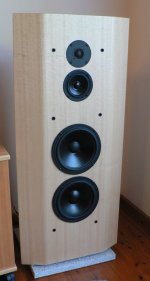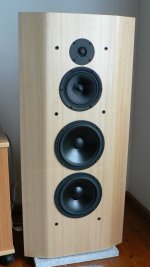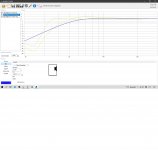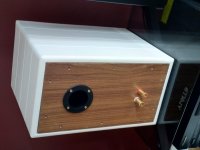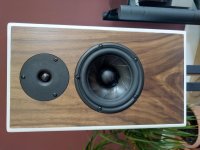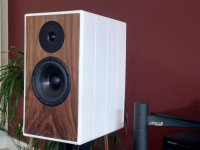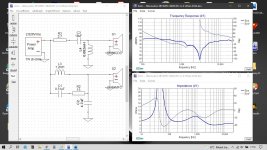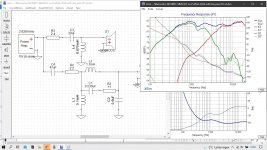Why don't you buy 15" driver for bass? One 15" bass equals all four 8" you listed, roughly. Why agonize which one to buy as you could get something that equals them all alone?
Last edited:
Great question 🙂Why don't you buy 15" driver for bass? One 15" bass equals all four 8" you listed, roughly. Why agonize which one to buy as you could get something that equals them all alone?
I almost just did. I bought two RS390HF to replace two of my four 12" subwoofers - because I experienced several places, how a 15" simply play the deeper frequencies in a more fun way than all smaller drivers 😀
My system is 3 way mains and 4 subwoofers. I like "slim" mains, to get an elegant look and good stereo image - but the subwoofers give me this realistic deep sound-scape, where you also feel the sound.
Nice! 🙂 Yes bigger speakers seem to kick *** but I'm not sure if it is an illusion or what. Not listening loud even, and still the music is felt. What kind of main speakers they are?
I don't necessarily play loud - just like the raw power when something happens in movies or music kicks in with dynamics.Nice! 🙂 Yes bigger speakers seem to kick *** but I'm not sure if it is an illusion or what. Not listening loud even, and still the music is felt. What kind of main speakers they are?
My system consist of a Groundsound DCN28 - 8 channel preamp/DSP with 2 x 3 channel(200W each channel) for the mains and 2 x 1000W for the subwoofers. Currently build an extra power amplifier and adding an 24RPC DSP, so that I can run 10 channels and make proper multi-subs.
Mains are build of Seas DXT, Dayton RS125 and 2 x SB 23NRX. Subwoofers are at the moment 2 x Peerless XXLS and 2 x Scanspeak Discovery 30W - all in each 90 liters closed boxes.
Just bought a set of SB 26ADC for a some printed Augerpro waveguides, a set of MW13TX-4 and now looking at potential woofer upgrades too 😀
Last edited:
Thanks for pointing me this one.You can obviously increase cabinet volume, see link below with a Troels PMS like speaker using a CA26RFX. Reading the build process is also interresting IMHO. Maybe I'll buid something like that one day 😉
Seas 3-way wide baffle
Unfortunately the cabinet needs to small. 40x100x12 is the limit.
I did a sim of the sb23nbac in a 25l and it seem to work sealed.
To make it more practical :
I want to make a design, wide baffle (40cm) ala Troels PMS with SBacoustic drivers.
SB26ADC, SB15MFC-8 and SB23MFCL45-8 comes to mind.
For learning you are better off starting with a 2-way using the SB26ADC and SB15MFC-8 you mentioned. That way you can try different xo's, boxes etc and learn as you go. That's much easier than starting with a 3-way which just adds so much more complexity. You can then progress to a 2.1 and then a 3-way.
BTW, never had much luck with the SB23MFCL but the other drivers are very good.
I've never nailed a great 3-way, only good. I did a wide baffle 3-way which went from a sealed mid and then OB as shown in the pics. The speaker was finally scrapped as was not good enough even though some thought it was fine.
Attachments
Thanks for your advice.For learning you are better off starting with a 2-way using the SB26ADC and SB15MFC-8 you mentioned. That way you can try different xo's, boxes etc and learn as you go. That's much easier than starting with a 3-way which just adds so much more complexity. You can then progress to a 2.1 and then a 3-way.
BTW, never had much luck with the SB23MFCL but the other drivers are very good.
I've never nailed a great 3-way, only good. I did a wide baffle 3-way which went from a sealed mid and then OB as shown in the pics. The speaker was finally scrapped as was not good enough even though some thought it was fine.
I agree that 3-way add a lot of complexity and a 2-way will be easier.
But having the CARRERA speaker a 2-way with SB26ADC and SB15MFC-8 will be kind of the same thing. Like electrostat style.
My idea is to go wide baffle so no baffle step needed for mid and tweeter.
If close to wall positioning maybe no baffle step needed at all.
If I can get mid and tweeter right, then it's possible to add the woofer with making adjustments to the mid and tweeter? (for near wall+wide baffle)
Of course mid will need a high pass filter added.
This way I can start off 2-way and see what is the best way to integrate the woofer. If this approach is possible of course.
The SB15MFC-8 seems difficult to model :-( If you happen to have an AR-XO for this driver it would help.
I made some sim with WINISD and SB23NBAC-8 seems to go closed into a 25L box. Maybe it is better choice then the MFCL version.
Peter, I never go the chance to upload my CARRERA build. Here some pic's. And the soundbar FR at the front and woofer on each side.
your design look very similar then the one I would like to build. Idea is to have some kind of closed panel speaker. wide, thin and high.
Attachments
Last edited:
The 2way would be a good learning tool and you can compare to the Carrera as you go along. I didn't do a AR Series xo for that combination but have used both drivers. A good starting point would the the xo I suggested in the Tributes thread. Even though it shows different drivers, the SB26ADC works in the same xo with a slightly smaller resistor and the SB17MFC has similar behaviour so shouldn't vary too much as a starting point.
https://www.diyaudio.com/community/threads/jeff-bagbys-tributes-build.288661/
A parallel xo would work better for the 2-way with adding a woofer to make a 3-way. For adding a woofer to make it a 3-way have a look at Jeff Bagby's Kairos paper and design for a guide.
http://meniscus.lightningbasehosted...he-Kairos-and-Continuum-Three-Way-Writeup.pdf
I no longer DIY as have had recent life changing events so would not be able to supply any support.
https://www.diyaudio.com/community/threads/jeff-bagbys-tributes-build.288661/
A parallel xo would work better for the 2-way with adding a woofer to make a 3-way. For adding a woofer to make it a 3-way have a look at Jeff Bagby's Kairos paper and design for a guide.
http://meniscus.lightningbasehosted...he-Kairos-and-Continuum-Three-Way-Writeup.pdf
I no longer DIY as have had recent life changing events so would not be able to supply any support.
Thanks Peter, I fully understand. Hope you get your life on track again. Best of luck.The 2way would be a good learning tool and you can compare to the Carrera as you go along. I didn't do a AR Series xo for that combination but have used both drivers. A good starting point would the the xo I suggested in the Tributes thread. Even though it shows different drivers, the SB26ADC works in the same xo with a slightly smaller resistor and the SB17MFC has similar behaviour so shouldn't vary too much as a starting point.
https://www.diyaudio.com/community/threads/jeff-bagbys-tributes-build.288661/
A parallel xo would work better for the 2-way with adding a woofer to make a 3-way. For adding a woofer to make it a 3-way have a look at Jeff Bagby's Kairos paper and design for a guide.
http://meniscus.lightningbasehosted...he-Kairos-and-Continuum-Three-Way-Writeup.pdf
I no longer DIY as have had recent life changing events so would not be able to supply any support.
I tried some XO designs. Dont have the drivers yet, so I used existing measurements on infinity baffle. I assume a wide baffle of 40cm will not be much difference for mid and tweet.
So far I came up with this for 2-way and 3-way (couldn't find measurements on 26ADC so used 26CDC instead. Dont think they are much different. Didnt find any measurement on SB23NBAC either so didnt add it, just make some estimate to cross around 300Hz)
I guess it's sufficient for first sim. When I can do measurements I can go further.
Anyone have any thoughts suggestions on the XO?
Attachments
Fddled around a bit. Made trace in vitiuxCAD of SB23NBAC45-8 and added it to my XO. Made some small adjustments. This is what I came up with so far. XO @300 & @2k6
Any comments/remarks/improvements/suggestions?


Any comments/remarks/improvements/suggestions?
I did my own version of the PMS too, reusing some Vifa paper bass and mid and bought new DXT tweeters. Good time alignment between mid and tweeter since the DXT is waveguided. I have never seen such smooth FR graphs as with this wide and rounded baffle (I made the rounding smooth). Almost textbook perfect LR2 acoustical slopes. Keep the baffle smooth, I did several iterations, tried some stepped baffle version first, but everything came together after I changed to the DXT tweeter and flat baffle with smooth rounding on the sides.When you come to the point where you stop feeling disconnected and everything falls into place?
I started my DIY journey 1,5y ago. Studied and read a lot. I know about baffle step compensation, phase, driver integration, diffraction, group delay, bass reflex, etc. Played with Xsim and boxSim.
But at that point knowing it is not enough to start my own build and decided to make a proven design.
Now I want to go the next step.
To make it more practical :
I want to make a design, wide baffle (40cm) ala Troels PMS with SBacoustic drivers.
SB26ADC, SB15MFC-8 and SB23MFCL45-8 comes to mind.
crossover low point aming for 300 Hz. Why 11600/40 = 300. Thats where baffle step comes in and should be addressed only to the woofer.
Woofer sensitivity is only 85db while mid is 87db.
Is it a good choice for woofer?
SB23NBACS45-8 has 87,5db sensitivity? Better choise? But cabinet volume (40x12X100 with big curve) is around 20-25L. So I think this woofer isn't suited.😕
When you want to cross that low (~300Hz) with passive XO, you should definitely consider impedance correction for the woofer, or it will resonate with the coil, boosting some low frequencies and adding group delay. Troels did not do this on the PMS.
I regret making the mid cavity small and 'box shaped' similar to Troels drawing, a little bit bigger and tapered or some 'irregular shape' would have been better I think, to let the mid 'breathe' more and minimize standing waves.
Brace and dampen it well, it has a large baffle area, so make every effort to make it 'dead'.
The fine tuning of my XO has been going on for a year or so since I first thought the speakers were finished, and complexity has grown with time. Would active XO be an alternative for you?
I think you will still have some 'baffle step compensation' as long as they are not on a wall, but it is in the XO-region around 300Hz, so the higher efficiency from the woofer would be nice, but I guess you would have to trade it for some LF or excursion depending on woofer parameters (I did not compare your suggestions).
Looking at your graphs above, I think you have some resonance phenomena happening on the HP slopes of the mid and tweeter (impedance peaks at driver resonances?). Maybe try a resistor (maybe 15ohms) in parallel to them and compare the slopes. I'm also a bit concerned about the breakup on the mid, could C1/R2 be adjusted a bit to smooth it out?
Last edited:
Hi,I did my own version of the PMS too, reusing some Vifa paper bass and mid and bought new DXT tweeters. Good time alignment between mid and tweeter since the DXT is waveguided. I have never seen such smooth FR graphs as with this wide and rounded baffle (I made the rounding smooth). Almost textbook perfect LR2 acoustical slopes. Keep the baffle smooth, I did several iterations, tried some stepped baffle version first, but everything came together after I changed to the DXT tweeter and flat baffle with smooth rounding on the sides.
When you want to cross that low (~300Hz) with passive XO, you should definitely consider impedance correction for the woofer, or it will resonate with the coil, boosting some low frequencies and adding group delay. Troels did not do this on the PMS.
I regret making the mid cavity small and 'box shaped' similar to Troels drawing, a little bit bigger and tapered or some 'irregular shape' would have been better I think, to let the mid 'breathe' more and minimize standing waves.
Brace and dampen it well, it has a large baffle area, so make every effort to make it 'dead'.
The fine tuning of my XO has been going on for a year or so since I first thought the speakers were finished, and complexity has grown with time. Would active XO be an alternative for you?
I think you will still have some 'baffle step compensation' as long as they are not on a wall, but it is in the XO-region around 300Hz, so the higher efficiency from the woofer would be nice, but I guess you would have to trade it for some LF or excursion depending on woofer parameters (I did not compare your suggestions).
Looking at your graphs above, I think you have some resonance phenomena happening on the HP slopes of the mid and tweeter (impedance peaks at driver resonances?). Maybe try a resistor (maybe 15ohms) in parallel to them and compare the slopes. I'm also a bit concerned about the breakup on the mid, could C1/R2 be adjusted a bit to smooth it out?
Thanks for sharing your thought.
Would you like to share some pictures of your design? I will make mine with sloped baffle. It seems 8-9 degrees bring the austic centers alined. Thats about 15cm for 1meter speaker.
I plan to make my PMS lookalike 40x100x12 cm. SB23NBAC has 87,5 db sensitivty on spec sheet.
What do you mean exactly with resonace phenomena happening on the HP slopes?
Notch on mid try to lower the peak at 6k. It is now 17db down. I tried to play a bit with C1/R2. But needs to make tradeoff in bringing the region of 6k and not bringing the 10k region to much up. maybe it still be fune-tuned a little though.
Would really appreciate if you can make things clear for me. Im still learning and need a lot of advice 😏
The fs of the tweeter is around 700Hz. That point is brought down 20db.
Maybe it would be better to make a separate thread for your project?
There are some 'knees' on the slopes, around 100Hz for the mid, which I think would be close to resonance for the mid, and therefor the cause. If you 'hold' the slope for the mid and add a 15ohm resistor in parallel with the driver for comparison, and the knee flattens out, it's a resonance. In that case you can do some tuning of the resistor, or ad a RLC to compensate for the impedance hump for the mid. Same goes for the tweeter.
Even if things like this are not visible on the summed FR, I found that they can color the sound. Many times you have some ringing going on at that frequency. I generally prefer FR curves that have no 'kinks/knees/bumps etc' just smooth rounded curves. You can try listening to the drivers one by one to hear 'colorations'.
There are some 'knees' on the slopes, around 100Hz for the mid, which I think would be close to resonance for the mid, and therefor the cause. If you 'hold' the slope for the mid and add a 15ohm resistor in parallel with the driver for comparison, and the knee flattens out, it's a resonance. In that case you can do some tuning of the resistor, or ad a RLC to compensate for the impedance hump for the mid. Same goes for the tweeter.
Even if things like this are not visible on the summed FR, I found that they can color the sound. Many times you have some ringing going on at that frequency. I generally prefer FR curves that have no 'kinks/knees/bumps etc' just smooth rounded curves. You can try listening to the drivers one by one to hear 'colorations'.
Can you explain why? I see many post it to show phase integrated between the drivers.@MrHifiTunes, there is nothing to be gained from showing your crossover with reversed polarity.
The only reason to do it is when your crossover simulator doesn't show phase. It may also be done when you are in the process of measuring drivers together and can't see their separate phase.
In addition to that, while phase is important, the idea that it has to be exact enough to give a sharp null is a myth, and has no basis in fact.
In addition to that, while phase is important, the idea that it has to be exact enough to give a sharp null is a myth, and has no basis in fact.
Thanks it make sense.
Is there some lecture about the importance of a sharp null? I think I may pay too much attention to it.
Is there some lecture about the importance of a sharp null? I think I may pay too much attention to it.
When you start to think of off-axis response, a sharp null is not always the right thing to do.
Is there some documentation on the subject?When you start to think of off-axis response, a sharp null is not always the right thing to do.
- Home
- Loudspeakers
- Multi-Way
- 3-way reference project??
